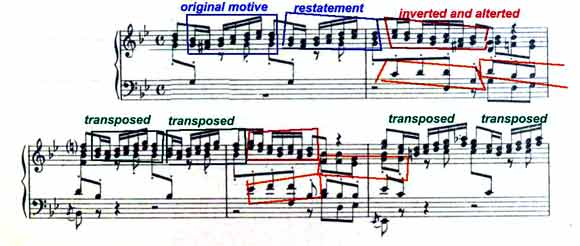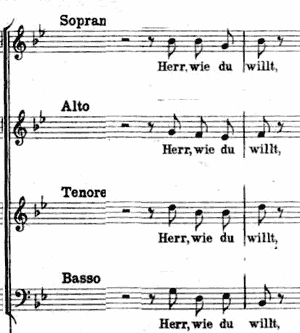This was the first cantata written by Bach for the third Sunday in Epiphany, early in 1724 in Leipzig. The overall tonal movement is downward from g minor in the first movement to c minor, through E-flat major. According to musicologist Eric Chafe, the cantata focuses on “the relinquishing of the self-determining will to God’s will, made manifest in the Holy Spirit. God’s will…often [demands] a life of suffering”. The tonal descent “mirrors man’s submission” (Chafe, Tonal Allegory in the Vocal Music of J.S. Bach). This is a lot to relay in a relatively short cantata that encompasses less than 14 minutes of music.
Bach’s original score has been lost, though the parts have survived. The librettist is likely Salomon Franck, though this is suggested by educated speculation rather than hard evidence. Additional text comes from Kaspar Beinemann’s chorale of 1582, “Wo Gott de Herr nicht bei uns halt”. Whoever the librettist might have been, the text draws on the Gospel reading for the day (Matthew 8: 1-13), which tells the story of Jesus healing the leper. The leper presents a pronounced image of mankind’s frailty, and provides the ultimate contrast between humans and the perfection of God. These are the two parties involved in the struggle Chafe identifies above. The title, and opening text, reflects mankind’s necessary response to God in this struggle – “Herr, wie du willt, so schicks mit mir” (“Lord, as You will, so ordain it unto me”). The idea of God’s will becomes a textually cohesive element throughout the cantata, appearing not only in the opening movement, but repeatedly in the bass aria and in the final chorale.
The opening chorus is an unusual and elaborate movement. It begins with an orchestral “prelude” of sorts, introducing a short rising motive in parallel thirds in the oboes (seen below), starting on the off-beat; this becomes a unifying element throughout the opening movement, appearing at least 38 times in its original form (including transposed statements, or using parallel sixths instead of thirds). Many additional statements appear in inversion and/or retrograde, or at least employing the same gesture.

This is not a true ritornello form, as we see in some of the orchestral works (see the Brandenburg Concertos, for example), but it reminds us of this in the continuous reintroduction of the initial motive – and sometimes, full phrases – from the opening orchestral material.
The movement is also not a typical opening chorale fantasia, although it is based on a text and melody from Beinemann’s chorale. What makes it so unusual is the interruption of phrases of the chorale, stated by the chorus, with solo passages by tenor, bass, and soprano soloists, in that order. The music is far more uncertain, uneven, and unpredictable in these solo passages – which are like accompanied recitatives – though the oboe motives help propel the music forward and create a sense of unity despite the seemingly disparate vocal and choral statements.
The other unifying idea appears initially in the bass line of the opening orchestral material. This at first is a four or five-note cadential idea, again starting off the beat, but leading to a strong downbeat or third beat. (See the orange markings in the example above.) We hear this eighth-note cadential idea throughout the solo recitative passages, but later it is transformed to be an affirming homophonic statement by the chorus, “Herr, wie du willt” (Lord, as You will), heard three times to end the movement.

The aria for tenor which follows is dominated again by the timbre of the oboe, this time a single oboe soloist, in a trio sonata texture. The movement turns from g minor to E-flat major, the only major-key movement in the cantata. Here, descending sixteenth-note passages dominate the movement; these descents reflect the movement of the Holy Spirit from heaven down to dwell in those of us on earth.

“Three” is also an idea which subtly pervades the movement:
- The key signature has three flats
- It is a major third below the opening movement (g minor to E-flat major)
- The movement is a da capo aria, meaning it follows an APA – or 3-part – form.
- There are three essential parts to the texture (solo oboe, solo tenor, continuo).
- In the opening (A) section, Bach states the complete text “Ach, senke doch den Geiste der Freuden dem Herzen ein” three times.
- The middle (B) section is in c minor, a third below the key of the A section.
- In the middle (B) section, Bach writes the same ascending motive three times in a row (on “es will ofte bei mir geistlich”) before abandoning the idea. (see below)

Why all of the threes? The entire text is about the Holy Spirit coming to dwell within us – the Holy Spirit is the third person of the Holy Trinity.
The B section of this da capo aria provides significant contrast in key, melody, and text to the A section. It is, in addition, more chromatic than the A section, which is expected in a shift to the minor mode, but there is at least one very poignant descending chromatic passage which receives extra emphasis because the perceived tempo slows down through the use of eighth notes and syncopations in the vocal line:

The chromatic descent, occasionally stalling on the syncopation – elongated notes, if you will – reflects the pain of the soul as it longs for the Lord, exactly a the text indicates.
After a short secco recitative, we arrive at another aria – the bass aria alluded to earlier. This follows immediately after the recitative, without interruption, as the initial text of the aria completes the final thought of the recitative. Listeners of Bach will immediately find a link to another, more famous Bach aria that known as “Abide with Me”.
The opening gesture in both is strikingly similar. This is a through-composed aria, providing good formal contrast with the tenor aria heard previously. Additional contrast to the former aria is provided in the choice of soloist (bass vs. tenor earlier), and the supportive scoring (here, the strings play a definite supportive role, whereas earlier the oboe had a featured role).

Despite the lack of large repeated section, as in a da capo aria, this aria has a similar feeling, promoted by Bach’s repetition of the “Herr, so du willt” idea. It’s not a da capo gesture, for here we have small repetitions, not entire sections, and the repetitions occur more often. Instead, the frequent reiterations of the opening text and motive lean towards a rondo form, which was common in the Viennese Classical style, In a rondo a main theme is presented at the beginning of a work or movement, then repeated in it entirety several time throughout, with contrasting themes interspersed. Here, I would not say an entire theme is stated and repeated throughout the movement, but rather a mere four notes, sometimes transposed, along with the same four words each time. Seven similar statements of this idea are heard, though there are additional statements of the text in various musical guises.
Once again, Bach is full of surprises with this movement. We are used to word painting in his cantatas, but rarely do we find the orchestration changing to reflect the text. Indeed, Bach does just this as the text changes to refer to the tolling of the death knell: at this very moment, a striking passage of pizzicato emerges, for just a few measures, but its imitation of the ringing of the bell is unmistakable. The bass soloist is neither distracted nor deterred by this intrusion; he continues his lament and prayer, resting his hopes on God’s will.
The cantata concludes with a four-part chorale with instruments doubling.










































